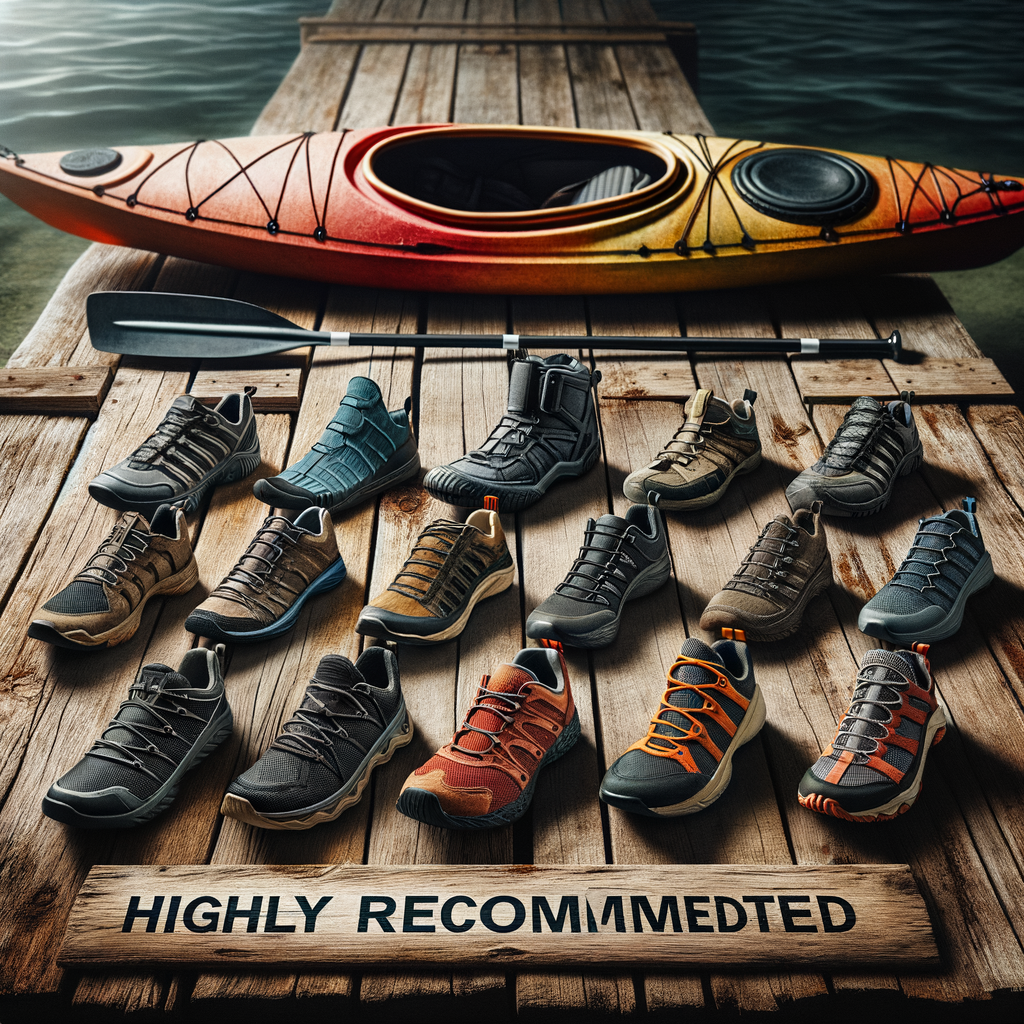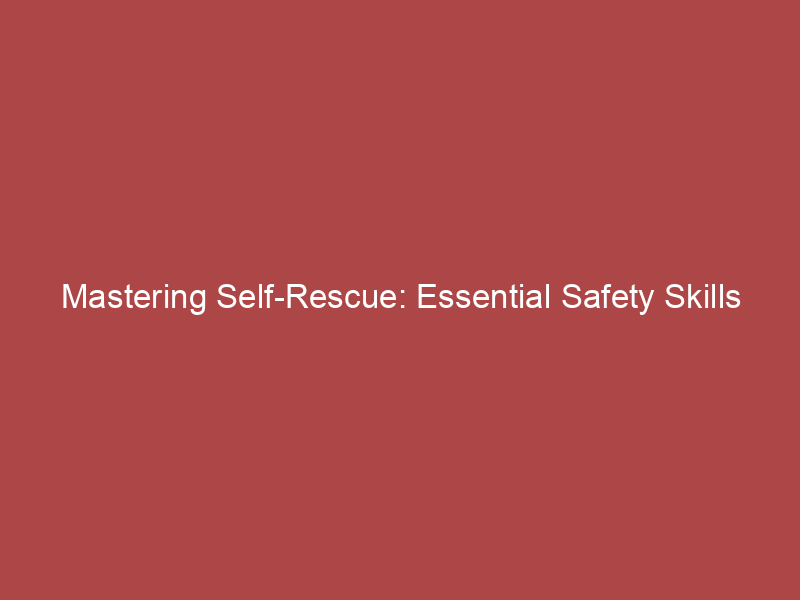
Introduction to Kayaking Footwear Essentials
When it comes to kayaking, the right footwear can make a significant difference in your overall experience. In this article, we will discuss the importance of choosing the right shoes for kayaking and help you understand the difference between regular shoes and kayaking shoes.
-
- Importance of choosing the right shoes for kayaking
Choosing the right shoes for kayaking is crucial for several reasons. Firstly, the right shoes provide the necessary grip and traction that are essential when navigating slippery surfaces. Secondly, they offer protection against sharp objects and rough surfaces that you may encounter during your kayaking adventure. Lastly, they ensure comfort and prevent blisters, which can be a common issue with ill-fitting shoes.
-
- Understanding the difference between regular shoes and kayaking shoes
While regular shoes and kayaking shoes may look similar, they are designed for different purposes. Regular shoes are typically designed for comfort and style, while kayaking shoes are designed with specific features to enhance your kayaking experience. For instance, kayaking shoes are made with quick-drying materials to keep your feet dry and comfortable. They also have non-slip soles for better grip on wet surfaces. Furthermore, they are typically more durable and offer better protection against the elements.
In the following sections, we will delve deeper into the key features of kayaking shoes, provide recommendations for the best shoes for kayaking, and offer tips on how to care for your kayaking shoes. So, stay tuned!
Understanding the Key Features of Kayaking Shoes
Material
When it comes to kayaking shoes, the material they are made of plays a significant role. The material can affect the shoe’s durability, comfort, and ability to keep your feet dry. Let’s explore the different types of materials used in kayaking shoes and their pros and cons.
-
- Types of materials used in kayaking shoes
There are primarily three types of materials used in the making of kayaking shoes. These are:
-
-
- Neoprene: Neoprene is a type of synthetic rubber that is highly resistant to water and provides excellent insulation. It is the most common material used in kayaking shoes.
- Rubber: Rubber is another common material used in the soles of kayaking shoes. It provides excellent grip, making it ideal for slippery surfaces.
- Mesh: Mesh is often used in the upper part of the shoe to allow for breathability and quick drying.
- Pros and cons of each material
-
| Material | Pros | Cons |
|---|---|---|
| Neoprene | Water-resistant, provides insulation, durable | Can be less breathable, may take longer to dry |
| Rubber | Excellent grip, durable | Can be heavy, less insulation |
| Mesh | Lightweight, breathable, quick-drying | Less durable, less insulation |
Choosing the right material for your kayaking shoes depends on your personal preferences and the conditions in which you plan to kayak. For colder conditions, a neoprene shoe might be the best choice. For warmer conditions or for those who prefer a lighter shoe, a mesh shoe could be the ideal choice.
Design
When it comes to the design of kayaking shoes, there are two main aspects to consider. These are the height of the shoe and the method of fastening. Let’s delve into these two aspects in more detail.
- High-top vs Low-top Kayaking Shoes
High-top kayaking shoes extend above the ankle, providing extra support and protection. They are ideal for colder weather and rougher waters, as they help to keep your feet warm and prevent water from entering the shoe. However, they may be less comfortable and harder to put on and take off than low-top shoes.
On the other hand, low-top kayaking shoes end below the ankle. They are lighter and more comfortable, making them a good choice for warmer weather and calm waters. However, they offer less protection and support than high-top shoes.
Both high-top and low-top kayaking shoes have their pros and cons. The best choice depends on the conditions in which you will be kayaking and your personal preferences.
- Slip-on vs Lace-up Design
Slip-on kayaking shoes are easy to put on and take off, making them convenient for quick transitions. They typically have a snug fit to prevent them from slipping off your feet in the water. However, they may not offer as much support as lace-up shoes.
Lace-up kayaking shoes provide a secure fit that can be adjusted to your comfort. They offer more support than slip-on shoes, making them a good choice for longer trips or rougher waters. However, they can take longer to put on and take off, and the laces can become untied in the water if not secured properly.
Again, the best choice between slip-on and lace-up kayaking shoes depends on your needs and preferences. Consider the conditions in which you will be kayaking, the length of your trips, and your comfort preferences when making your decision.
Fit and Comfort
When it comes to kayaking shoes, the right fit and comfort are paramount. Let’s dive into why these aspects are so important and how you can ensure they are met.
-
- Importance of the Right Fit in Kayaking Shoes
Having the right fit in your kayaking shoes is not just about comfort, but also about safety. Shoes that are too tight can restrict blood flow and cause discomfort, while those that are too loose can lead to blisters and instability. In a worst-case scenario, ill-fitting shoes can even fall off during a kayaking trip, leaving you barefoot and vulnerable.
When your shoes fit correctly, they will feel snug but not tight. You should be able to wiggle your toes freely, but the shoes should not slip or move around on your feet. This ensures that you have the control and stability you need when navigating through the water.
-
- How to Ensure Comfort While Kayaking
Comfort is key when you’re out on the water for hours at a time. Here are some tips to ensure your comfort while kayaking:
-
- Choose the Right Material: Look for shoes made of breathable, quick-drying materials to keep your feet dry and comfortable.
- Consider the Design: High-top shoes provide more ankle support, while low-top shoes allow for more freedom of movement. Choose the design that feels most comfortable for you.
- Try Them On: Always try on kayaking shoes before you buy them. Wear the same type of socks you plan to wear while kayaking to get the most accurate fit.
- Break Them In: Wear your new shoes around the house for a few days before your kayaking trip to break them in and prevent blisters.
The right fit and comfort in your kayaking shoes can greatly enhance your experience on the water. So, take the time to find the perfect pair for you.
Best Shoes for Kayaking: Top Picks
When it comes to kayaking, the right footwear can make a significant difference in your comfort and safety. Let’s take a closer look at our top pick for the best overall kayaking shoe.
Best Overall Kayaking Shoe
Our top pick for the best overall kayaking shoe is the Water Grip Kayak Shoe. This shoe stands out for its exceptional performance, comfort, and durability.
- Features: The Water Grip Kayak Shoe is designed with a quick-drying mesh upper and a rubber sole that offers excellent grip on wet surfaces. It also features a cushioned insole for added comfort and a bungee lacing system for a secure fit.
- Benefits: This shoe provides superior traction, preventing slips and falls on slippery surfaces. The quick-drying material keeps your feet dry, while the cushioned insole provides comfort during long kayaking trips. Furthermore, the bungee lacing system ensures the shoe stays securely on your foot, even in rough waters.
Whether you’re a beginner or an experienced kayaker, the Water Grip Kayak Shoe is a reliable choice that offers excellent value for money. It combines all the essential features of a great kayaking shoe into one package, making it our top pick for the best overall kayaking shoe.
Best Budget Kayaking Shoe
When it comes to kayaking, you don’t have to break the bank to get a good pair of shoes. The best budget kayaking shoe offers a blend of comfort, durability, and functionality without costing a fortune. Let’s take a closer look at the features and benefits of our top budget pick.
- Comfort: The shoe is designed with a soft inner lining and cushioned footbed to ensure maximum comfort during long kayaking trips. It fits snugly around your foot, providing a comfortable experience even after hours of use.
- Durability: Despite being a budget pick, this shoe doesn’t compromise on durability. It’s made from high-quality materials that resist wear and tear, ensuring that the shoe lasts for many kayaking adventures to come.
- Functionality: The shoe features a non-slip sole for excellent grip on wet surfaces, a crucial feature for any kayaking shoe. It also has quick-drying properties, so your feet stay dry and comfortable throughout your trip.
- Price: Perhaps the most significant benefit of this shoe is its price. It offers all the essential features of a good kayaking shoe at a fraction of the cost of high-end models. This makes it an excellent choice for beginners or those on a tight budget.
The best budget kayaking shoe provides a perfect balance of comfort, durability, and functionality at an affordable price. It proves that you don’t need to spend a lot to enjoy a safe and comfortable kayaking experience.
Best High-End Kayaking Shoe
When it comes to high-end kayaking shoes, the quality, comfort, and durability are unmatched. Let’s explore the features and benefits of our top high-end pick.
-
- Superior Material: High-end kayaking shoes are made from top-notch materials. They are designed to withstand harsh conditions and provide maximum comfort. The use of premium neoprene and rubber ensures that the shoes are both flexible and durable.
-
- Excellent Traction: One of the standout features of high-end kayaking shoes is their excellent traction. This is crucial for maintaining balance and stability on slippery surfaces. The soles are designed with unique patterns that grip onto wet surfaces, reducing the risk of slips and falls.
-
- Thermal Protection: High-end kayaking shoes provide excellent thermal protection. They are designed to keep your feet warm in cold water conditions, enhancing your comfort and performance.
-
- Comfort and Fit: These shoes are designed with comfort in mind. They have a snug fit, ensuring that they stay on your feet even in rough water conditions. The interior is lined with soft material, reducing friction and preventing blisters.
- Durability: High-end kayaking shoes are built to last. They can withstand repeated use in harsh conditions without showing signs of wear and tear. This makes them a worthwhile investment for serious kayakers.
In conclusion, high-end kayaking shoes offer superior comfort, excellent traction, thermal protection, and durability. They are a great investment for those who are serious about their kayaking adventures and are looking for footwear that can keep up with their passion.
How to Care for Your Kayaking Shoes
Proper care and maintenance of your kayaking shoes can significantly extend their lifespan and ensure they continue to provide the comfort and protection you need. Here are some essential tips on how to keep your shoes in top shape.
-
- Cleaning and Maintenance Tips
Keeping your kayaking shoes clean is crucial. After each use, rinse them thoroughly with fresh water to remove any salt, sand, or small pebbles that can cause damage over time. Use a soft brush to clean the soles and remove any stubborn dirt. Avoid using harsh detergents as they can degrade the material of the shoes. Once cleaned, let them air dry naturally, away from direct sunlight or heat sources, which can cause the shoes to shrink or warp.
-
- How to Extend the Lifespan of Your Kayaking Shoes
Aside from regular cleaning, there are other ways to extend the lifespan of your kayaking shoes. One is to ensure that you’re using the shoes as intended. Kayaking shoes are designed for water use, so avoid wearing them on rough terrains or for long walks. Also, store your shoes properly when not in use. Keep them in a cool, dry place and avoid squashing them to maintain their shape. Regularly check your shoes for any signs of wear and tear. Small issues, like a loose seam, can quickly become a big problem if not addressed promptly. By following these tips, you can enjoy your kayaking adventures for many seasons to come.
Taking care of your kayaking shoes doesn’t require much effort, but it can significantly impact their longevity and performance. Remember, the better you care for your shoes, the better they’ll care for your feet.
Common Mistakes When Choosing Kayaking Shoes
Choosing the right pair of kayaking shoes can make a significant difference in your kayaking experience. However, many people make common mistakes when selecting their footwear. Let’s take a look at these errors to help you avoid them.
-
- Ignoring the Fit
One of the most common mistakes people make when choosing kayaking shoes is ignoring the fit. It’s crucial to remember that comfort is key when you’re out on the water. Shoes that are too tight can cause discomfort and even lead to blisters, while shoes that are too loose may not provide the necessary support and could potentially slip off. Always try on different sizes and styles to find the perfect fit for your feet.
-
- Choosing the Wrong Material
Another mistake is choosing shoes made from the wrong material. Not all materials are suitable for water activities. For instance, leather shoes may look stylish, but they are not ideal for kayaking as they can absorb water and become heavy. Instead, opt for shoes made from quick-drying and breathable materials like neoprene or mesh.
-
- Overlooking the Importance of Design
The last common mistake is overlooking the importance of the shoe’s design. The design of your kayaking shoes can significantly impact their performance. For example, shoes with thick soles may offer better protection against sharp rocks, but they might also limit your foot’s flexibility. Similarly, shoes with a high-cut design can provide extra ankle support but may also restrict movement. Therefore, it’s essential to consider how the shoe’s design will affect your kayaking experience.
When choosing kayaking shoes, it’s important to consider the fit, material, and design. By avoiding these common mistakes, you can ensure that your shoes enhance your kayaking experience rather than hinder it.
Conclusion: Choosing the Right Shoes for Kayaking
As we come to the end of our comprehensive guide on kayaking footwear, it’s time to recap the key points and share some final thoughts on making the right choice. Remember, the right shoes can make a significant difference in your kayaking experience.
-
- Recap of the kayaking shoe guide
We started with an introduction to the essentials of kayaking footwear, emphasizing the importance of comfort, durability, and functionality. We then explored the key features of kayaking shoes, such as water resistance, grip, and insulation, which are crucial for a safe and enjoyable kayaking experience.
Next, we reviewed some of the top picks for the best shoes for kayaking, providing you with a variety of options to suit different needs and budgets. We also discussed how to care for your kayaking shoes to ensure they last longer and perform better.
Lastly, we highlighted common mistakes when choosing kayaking shoes, such as prioritizing style over function or neglecting to consider the shoe’s fit and material. These insights will help you avoid pitfalls and make an informed decision.
-
- Final thoughts on selecting the perfect kayaking shoes
Choosing the right shoes for kayaking is not just about style or cost. It’s about finding a pair that offers the right balance of comfort, durability, and functionality. The perfect kayaking shoes should keep your feet dry, provide excellent grip, and withstand the rigors of the sport.
Remember, every kayaker’s needs are different. What works for one person may not work for another. Therefore, it’s essential to understand your specific needs and preferences before making a decision. With the information provided in this guide, you’re now well-equipped to make an informed choice.
Happy kayaking!





